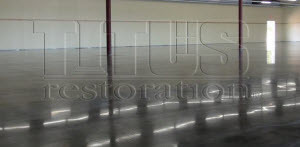 Manufacturing polished concrete floors is a process that’s completed after the slab has been poured. No polished concrete company can promise a flawless outcome, because so many variables can come into play during the pouring of the concrete. The composition of the concrete matrix, the ambient temperature and humidity, and the stability of the earth underneath the slab are just a few things that can affect the concrete floor. Unfortunately, your polished concrete contractor cannot control any of these factors.
Manufacturing polished concrete floors is a process that’s completed after the slab has been poured. No polished concrete company can promise a flawless outcome, because so many variables can come into play during the pouring of the concrete. The composition of the concrete matrix, the ambient temperature and humidity, and the stability of the earth underneath the slab are just a few things that can affect the concrete floor. Unfortunately, your polished concrete contractor cannot control any of these factors.
The good news is your polished concrete contractor has a lot of tools at his disposal that can mitigate a lot of potential issues. Keep reading to learn about the four best kept secrets about manufacturing polished concrete floors (or read up on concrete polishing here):
It is not always possible to have a consistent color across the entire concrete floor.
Various things can cause blemishes in the slab including fibers, footprints, foreign objects, excess moisture, and aggregate exposure. For concrete contractors, grinding and polishing the floor to a smooth, even surface is considered more important than having even tones. Many property owners don’t have a problem with this, and some even take great delight when aggregate is exposed. This can create a unique and attractive floor surface.
If there was previously tile or another floor covering on top of the concrete, it’s likely that ghosting will be visible on the finished concrete.
Ghosting is a pattern left behind by the flooring and/or its adhesive material. These faint lines often cannot be ground away by your polished concrete contractor, but they will typically not affect the smoothness or hardness of the slab.
Sweating slab syndrome is a condition that causes a slick concrete surface.
This can pose a danger to people and equipment traveling over the floor. There may also be a fine white powder present on the surface, and this salty powder can be stirred into the air where it may contaminate any surface in the vicinity. Sweating slab syndrome can be treated using a three-step process: neutralize salts, impede the moisture within the slab, and restrict the concrete capillaries to prevent more salts from reaching the slab surface.
When a soft concrete slab is poured, it’s possible for sand particles and larger aggregate pieces to pop out of the concrete.
When this happens, the concrete surface will appear to be pitted. These pits can be filled in with grout coat and then polished to a high shine. This improves the integrity, appearance, and smoothness of the concrete surface.
Thanks to advances in products and techniques, there are a lot of issues that your polished concrete contractor can address. However, we can only do so much to improve slabs that were improperly poured in the first place. Call 888-569-3914 to find out what the experts can do to help you in manufacturing polished concrete floors for your facility.
